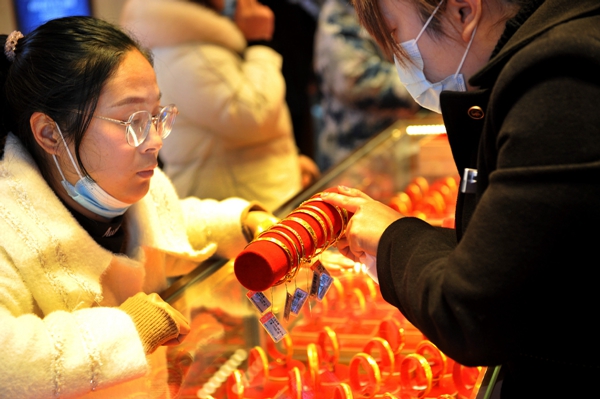Gold consumption soars during festival
 0 Comment(s)
0 Comment(s) Print
Print E-mail China Daily, February 17, 2022
E-mail China Daily, February 17, 2022

Gold consumption in the nation during Chinese Lunar New Year boomed, indicating rosy growth prospects, with promotions from retailers and relatively low prices enhancing the attractiveness of the precious metal for many Chinese consumers, the World Gold Council said.
During the Spring Festival break in the first week of February, gold jewelry consumption in Shanghai reached 1.1 billion yuan ($171.8 million), up 12 percent year-on-year. As it is the Year of the Tiger, tiger-themed gold products and heritage gold jewelry were popular, the Shanghai Gold Jewelry Association said.
In the first 15 days of the first month of the Chinese lunar calendar, consumption of gold in China went up by 12 percent year-on-year, the council said.
Due to sporadic outbreaks of COVID-19 variants in different regions in the country, many Chinese travelers chose to cancel their travel plans and stay put during the Spring Festival holiday. Their freed-up travel budgets may have provided a further boost to gold jewelry purchases, the council said.
"We remain relatively positive on the 2022 outlook for gold demand in China, despite the possibility of a slowdown in the country's economic growth," said Ray Jia, senior analyst on China for the World Gold Council.
Compared to other markets, China's gold jewelry market shows a higher price transparency, and young Chinese consumers have shown an increasing interest in gold jewelry, fueled by their shifting tastes and mindset toward gold jewelry as an investment and a consumer product.
In addition, there has been a greater push from commercial banks in bar and coin sales as their other retail gold business remains restricted, a dynamic that could impact gold demand in China this year, the council said.
"Traditionally, there is a demand among consumers to buy gold products during the Spring Festival period. Besides, the popularity of the Beijing 2022 Winter Olympics has boosted the sales of some related gold products and jewelry," said Li Yang, a gold industry analyst.
China's gold imports in 2021 totaled 818 metric tons, a 36 percent increase year-on-year on the back of a strong recovery in local gold consumption. It was close to the 2019 level, when there was no COVID-19 pandemic, according to data from the General Administration of Customs.
After reaching an all-time high in December as investors took advantage of lower gold prices, collective holdings in Chinese gold ETFs (exchange-traded funds) fell nine tons to 66 tons, or $4 billion at the end of January.
"Investors tend to cash their investments in before the Chinese Lunar New Year to avoid uncertainties in the global gold market during the Chinese holiday week. Second, weakness in the gold price and a hawkish US Fed might have persuaded investors to reduce their ETF holdings in anticipation of a bearish gold price performance in the short run," Jia of the World Gold Council said.






Go to Forum >>0 Comment(s)